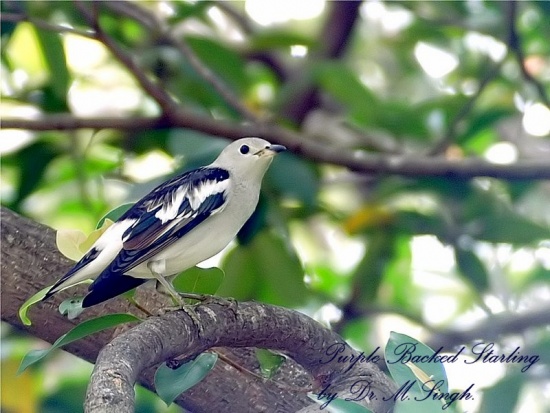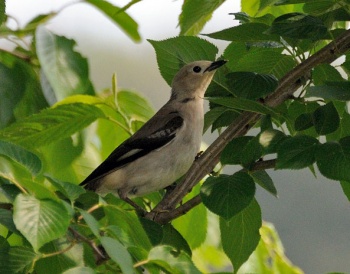
Photo © by the late Dr Manjeet Singh
Tmn Panadamaran-jaya, Port Klang, Malaysia, October 2006
Alternative name: Purple-backed Starling
- Agropsar sturninus
Sturnia sturnina, Sturnus sturninus
Identification
17cm. A small, short-tailed Starling.
Male
- Grey head and upper mantle
- Glossy purple patch on rear crown
- Glossy purple lower mantle and back
- White or pale brownish rump
- Two whitish wingbars, primaries brown, secondaries glossy green
- Black tail with green gloss
- Pale grey from chin to breast and on flanks
- Creamy white belly and undertail-coverts
- Dark brown eye
- Black bill in breeding season, with pale base in non-breeding season
- Greenish-grey legs
Female
- Mousy brown forehead, crown and mantle
- Paler rump
- Pale brown chin to breast and flanks
- Brown wings with paler inner secondaries and buffy white secondary coverts
- Brown tail with slight mauve gloss
Juveniles are grey with a brownish back and without nape patch
Distribution
Breeds in eastern Mongolia, southeast Russia, northeast and central China and North Korea.
Winters in southeast Asia (southern Thailand, Malaysia) and Greater Sundas (Sumatra, Java).
Recorded on passage or as vagrant in many countries like Japan or Taiwan. One record in the United Kingdom has been classified in category D (unknown origin).
Fairly common in most of its range.
Taxonomy
May form a superspecies with Chestnut-cheeked Starling.
It has been placed in the genus Sturnia and in Sturnus.
Subspecies
This is a monotypic species[1].
Habitat
Breeds in mixed forest, open woodland, riparian woodland and villages, usually in the lowlands.
Outside breeding season also in secondary growth, coastal scrub, cultivation, fallow lands, gardens and parks.
Behaviour
In breeding season seen in pairs or small groups, outside breeding season gregarious and often in large parties, often associating with Asian Glossy Starling.
Forms communal roosts in reedbeds in winter together with Asian Glossy Starling, Common Myna and Javan Myna.
Diet
Feeds mainly on insects, takes also earthworms, fruit and some seeds.
Breeding
Breeding season from May to June. A solitary, monogamous nester. The nest is placed in a tree hole (including holes of White-backed Woodpeckers), in a hole in a wall or house or in a nestbox. Lays 5 -6 eggs.
Nest parasitism by White-cheeked Starling recorded.
References
- Clements, J. F., P. C. Rasmussen, T. S. Schulenberg, M. J. Iliff, T. A. Fredericks, J. A. Gerbracht, D. Lepage, A. Spencer, S. M. Billerman, B. L. Sullivan, and C. L. Wood. 2023. The eBird/Clements checklist of Birds of the World: v2023. Downloaded from https://www.birds.cornell.edu/clementschecklist/download/
- Del Hoyo, J, A Elliott, and D Christie, eds. 2009. Handbook of the Birds of the World. Volume 14: Bush-shrikes to Old World Sparrows. Barcelona: Lynx Edicions. ISBN 978-8496553507
Recommended Citation
- BirdForum Opus contributors. (2025) Daurian Starling. In: BirdForum, the forum for wild birds and birding. Retrieved 14 May 2025 from https://www.birdforum.net/opus/Daurian_Starling
External Links
GSearch checked for 2020 platform.1





